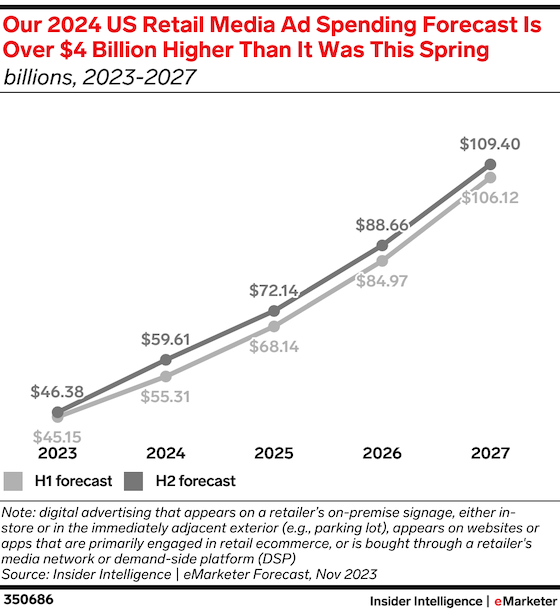The latest forecasts and insights shed light on significant trends that are shaping the retail media landscape. As of October 2023, an overwhelming 81.5% of retail media ad spend is directed toward on-site formats. However, as advertisers aim to reach consumers at every possible touchpoint, off-site formats such as in-store, streaming, and social media are gaining traction. Let's delve into these channels, exploring audience insights and their implications for marketers.
1. In-Store Media: Capitalizing on Buying Mode
In-store advertising is experiencing a renaissance, thanks to its ability to engage consumers who are in a prime state of readiness to buy. Retail media expert Andrew Lipsman highlighted during a Meet the Analyst Webinar that in-store audiences surpass digital counterparts by an average of 84%, with giants like Walmart and Target leading the pack in monthly visitor counts. The unique advantage of in-store media lies in its setting. Consumers present in physical stores are not just potential buyers but are actively comparing, learning, and making decisions about products. This active engagement offers advertisers an invaluable opportunity to influence purchase decisions through targeted messaging, boosting brand awareness, facilitating product trials, and aiding in price comparisons without necessitating an immediate purchase.
2. Streaming Media: Building Brand Awareness
Although streaming viewers may not always be in a direct buying mode, the platform offers a vast landscape for brand visibility. With over 250.5 million US consumers projected to use OTT video services in 2023, platforms like YouTube, Netflix, and Hulu present significant opportunities for advertisers. Retailers like Walmart and The Home Depot are already leveraging this space through partnerships for interactive shoppable ads, while Amazon enhances its ad business within Prime Video. The sheer volume of viewers and the time spent on these platforms underscore streaming media's potential for raising brand awareness and even inspiring purchases through innovative ad formats.
3. Social Media: Driving Awareness and Conversions
The social media sphere is another critical battleground for advertisers, with US adults spending an average of 1 hour and 48 minutes daily across platforms in 2024. TikTok and Instagram lead in engagement time, signaling the importance of these platforms for targeting specific demographics. Social media's strength lies in its versatility: not only can it drive brand awareness, but it also supports direct conversions through shoppable ads. The demographic segmentation across platforms—from Gen Z's preference for TikTok and Snapchat to millennials and Gen Xers favoring Instagram, YouTube, and Facebook—highlights the need for tailored strategies. Engaging with influencers and creators on these platforms can further amplify brand messages, particularly in sectors like beauty, fashion, and home goods.
The Full-Funnel Approach: A Strategic Imperative
While traditional search and display advertising continue to hold value, integrating these with off-site formats across streaming and social channels can create a comprehensive full-funnel marketing strategy. This approach not only boosts brand awareness but also drives conversions, tapping into consumers' preferences and behaviors across different stages of their buying journey. By leveraging in-store media's direct influence on purchase decisions, alongside the broad reach and engagement capabilities of streaming and social media, advertisers can craft a more holistic and effective retail media strategy.
In conclusion, the evolving retail media landscape demands a nuanced understanding of consumer behaviors and preferences across various channels. By strategically harnessing the unique strengths of in-store, streaming, and social media, brands can enhance their visibility, engage consumers more effectively, and ultimately drive more conversions. As we move forward, these trends will undoubtedly continue to shape the future of retail marketing, underscoring the importance of adaptability and innovation in advertising strategies.
Reference: Insider Intellence




